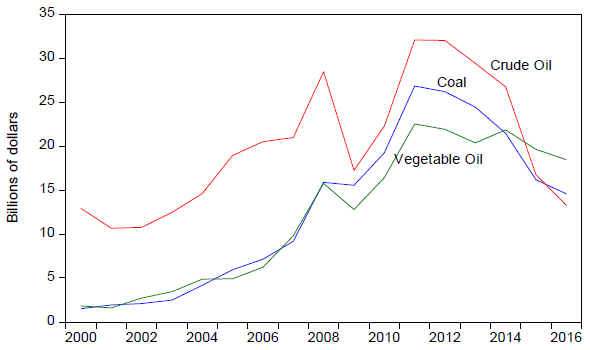| Author Name | Willem THORBECKE (Senior Fellow, RIETI) |
|---|---|
| Research Project | East Asian Production Networks, Trade, Exchange Rates, and Global Imbalances |
| Download / Links |
This Non Technical Summary does not constitute part of the above-captioned Discussion Paper but has been prepared for the purpose of providing a bold outline of the paper, based on findings from the analysis for the paper and focusing primarily on their implications for policy. For details of the analysis, read the captioned Discussion Paper. Views expressed in this Non Technical Summary are solely those of the individual author(s), and do not necessarily represent the views of the Research Institute of Economy, Trade and Industry (RIETI).
Macroeconomy and Low Birthrate/Aging Population (FY2016-FY2019)
East Asian Production Networks, Trade, Exchange Rates, and Global Imbalances
The Indonesian rupiah depreciated 50 percent between July 2011 and January 2019. U.S. interest rate hikes and global turmoil acted as pull factors and Indonesian current account deficits and uneven fundamentals acted as push factors to generate capital outflows and weaken the currency. Blanchard et al. (2015) showed that outflows from emerging markets can increase the cost of financial intermediation and reduce output. They also demonstrated that the resulting exchange rate depreciations can increase net exports and output.
This paper investigates how the rupiah affects the banking sector and the Indonesian economy. To do this, it first examines how the rupiah/dollar exchange rate affects industry and aggregate stock returns. Economic theory holds that stock prices equal the expected present value of future net cash flows, implying that stock prices provide information about future economic activity. The results indicate that stocks in the aggregate are exposed to a rupiah depreciation. A one percent depreciation will cause aggregate returns to fall by almost one percent. Looking at individual sectors, only five out of 62 individual sectors are exposed to depreciations. Of these five, three are in the banking sector. These results indicate that the weakening rupiah reduces bank profitability.
Unlike during the Asian Financial Crisis, Indonesian banks now earn high profits, possess abundant liquidity, and have a capital adequacy ratio exceeding 23 percent. However, 71 percent of bank loans go to corporations, and 45 percent of corporate debt is denominated in foreign currency. Banks are thus exposed to exchange rate depreciations through their corporate loans and corporations are directly exposed to depreciations. The Indonesian government should promote sound risk management practices such as requiring banks to hold sufficient liquid foreign currency assets to meet extraordinary foreign exchange needs over a 30-day period and extending corporate prudential foreign exchange regulations to all corporate foreign exchange liabilities.
Does a rupiah depreciation have the offsetting benefit that Blanchard et al. (2015) highlighted of stimulating exports? To investigate this question both times series and panel data methods are employed. Both approaches indicate that a weaker exchange rate will not increase Indonesia’s exports. One reason for this is that half of Indonesia’s exports are food, agricultural products, minerals, energy and other primary products. These goods are often denominated in U.S. dollars. A depreciation of the rupiah is associated with an appreciation of the U.S. dollar. When the dollar appreciates, the prices of primary products in terms of the importing countries’ currencies increase and they import less. This offsets the price competitiveness gains that manufactured products receive from depreciations.
Indonesia’s three leading export categories are vegetable oil, coal, and crude oil. As Figure 1 shows, the value of these exports rose before the 2008 Global Financial Crisis as commodity prices rose and tumbled after 2012 as commodity prices fell. Depending on primary exports thus exposes Indonesia to changes in world commodity prices. To investigate how diversification could reduce the impact of these price shocks, this paper examines the correlations between Indonesia’s aggregate export price and world prices for individual goods. It finds large positive correlations between Indonesia’s export prices and the prices of primary products such as iron, steel, aluminum, natural gas, paper, copper, and rubber. It also finds negative correlations between Indonesia’s export prices and the prices of both electronics goods such as computers, computer parts, cellphones, integrated circuits, televisions, and cameras and of labor-intensive manufactures such as textiles, apparel, toys, and footwear. Exporting more manufacturing products would thus reduce Indonesia’s exposure to negative terms of trade shocks.
This paper considers how Indonesia can increase its manufacturing exports. It recommends that Indonesia follow Malaysia, Thailand, and Vietnam and attract foreign direct investment (FDI) from multinational corporations (MNCs) seeking efficient export platforms. Indonesia could pursue FDI by improving electricity supply, fighting corruption, reducing onerous severance pay requirements, resisting protectionism that increases the cost of imported inputs, investing in human capital and encouraging entrepreneurship. Now is an opportune time to focus on this strategy, as MNCs are seeking to diversify out of China.

Note: The International Standard Industrial Classification codes for these products are 1514 for vegetable oils, 1010 for coal, and 1110 for crude oil.
- Reference(s)
-
- Blanchard, Olivier, Jonathan D. Ostry, Atish R. Ghosh, and Marcos Chamon. 2015. ‘Are Capital Inflows Expansionary or Contractionary? Theory, Policy Implications, and Some Evidence.’ NBER Working Papers 21619, National Bureau of Economic Research, Cambridge, MA.

